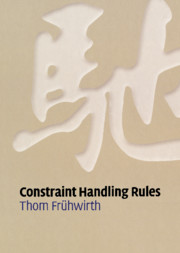1 - Getting started
from Part I - CHR tutorial
Published online by Cambridge University Press: 10 February 2010
Summary
This chapter is a basic introduction to CHR using simple examples. They introduce the types of rules used in CHR, their behavior and basic ingredients of the language such as logical variables and built-in constraints. Last but not least, we define the concrete syntax of CHR and we informally describe how CHR executes its rules.
In this book, we will use the concrete syntax of CHR with Prolog as the host language in the practical programming parts and mathematical abstract syntax in the formal Part II.
How CHR works
For programming, we recommend using a CHR implementation from K.U. Leuven, since they are currently the most recent and advanced. The CHR rules themselves will also be executable in other Prolog implementations of CHR and with minor modifications in K.U. Leuven JCHR, an implementation of CHR in Java and in the K.U. Leuven CHR library for C.
When we write a CHR program, we can mix host language statements and CHR code. The CHR-specific part of the program consists of declarations and rules.
Propositional rules
We start programming in CHR with rules that only involve propositions, i.e. constraints without arguments. Syntactically, constraints are similar to procedure calls.
Example 1.1.1 (Weather) Everybody talks about the weather, and we do as well.
Declarations. They introduce the CHR constraints we are going to define by the rules. They are specific to the implementation and the host language. Later in this book, we will usually skip the declarations and concentrate on the rules.
- Type
- Chapter
- Information
- Constraint Handling Rules , pp. 3 - 16Publisher: Cambridge University PressPrint publication year: 2009
- 1
- Cited by

